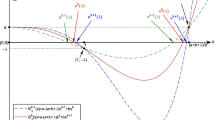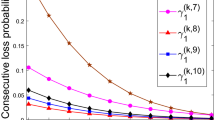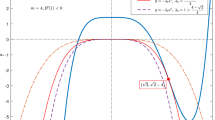Abstract
We consider a retrial queue with a finite buffer of size N, with arrivals of ordinary units and of negative units (which cancel one ordinary unit), both assumed to be Markovian arrival processes. The service requirements are of phase type. In addition, a PHL,N bulk service discipline is assumed. This means that the units are served in groups of size at least L, where 1≤ L≤ N. If at the completion of a service fewer than L units are present at the buffer, the server switches off and waits until the buffer length reaches the threshold L. Then it switches on and initiates service for such a group of units. On the contrary, if at the completion of a service L or more units are present at the buffer, all units enter service as a group. Units arriving when the buffer is full are not lost, but they join a group of unsatisfied units called “orbit”. Our interest is in the continuous-time Markov chain describing the state of the queue at arbitrary times, which constitutes a level dependent quasi-birth-and-death process. We start by analyzing a simplified version of our queueing model, which is amenable to numerical calculation and is based on spatially homogeneous quasi-birth-and-death processes. This leads to modified matrix-geometric formulas that reveal the basic qualitative properties of our algorithmic approach for computing performance measures.
Similar content being viewed by others
References
Anisimov, V.V. and J.R. Artalejo (2001). “Analysis of Markov Multiserver Retrial Queues with Negative Arrivals.” Queueing Systems 39, 157–182.
Artalejo, J.R. (1999). “Accessible Bibliography on Retrial Queues.” Mathematical and Computer Modelling 30, 1–6.
Artalejo, J.R. and A. Gómez-Corral (1999). “On a Single Server Queue with Negative Arrivals and Request Repeated.” Journal of Applied Probability 36, 907–918.
Artalejo, J.R. (2000). “G-Networks: A Versatile Approach for Work Removal in Queueing Networks.” European Journal of Operational Research 126, 233–249.
Artalejo, J.R., A. Gómez-Corral, and M.F. Neuts (2000). “Numerical Analysis of Multiserver Retrial Queues Operating Under a Full Access Policy.” In G. Latouche and P. Taylor (eds.), Advances in Algorithmic Methods for Stochastic Models, Notable Publications, Inc., New Jersey, pp. 1–19.
Artalejo, J.R., A. Gómez-Corral, and M.F. Neuts (2001). “Analysis of Multiserver Queues with Constant Retrial Rate.” European Journal of Operational Research 135, 569–581.
Asmussen, S. and Koole G. (1993). “Marked Point Processes as Limits of Markovian Arrival Streams.” Journal of Applied Probability 30, 365–372.
Bailey, N.T.J. (1954). “A Continuous Time Treatment of a Single Queue Using Generating Functions.” Journal of the Royal Statistical Society B16, 288–291.
Bini, D.A., S.R. Chakravarthy, and B. Meini (2000). “Control of the BMAP/PH/1/K Queue with Group Services.” In G. Latouche and P. Taylor (eds.), Advances in Algorithmic Methods for Stochastic Models, Notable Publications Inc., New Jersey, pp. 57–72.
Bright, L. and P.G. Taylor (1995). “Calculating the Equilibrium Distribution in Level Dependent Quasi-Birth-And-Death Processes.” Stochastic Models 11, 497–525.
Chakravarthy, S.R. (1993). “Analysis of a Finite MAP/G/1 Queue with Group Services.” Queueing Systems 13, 385–407.
Chakravarthy, S.R. and A.N. Dudin (2002). “A Multi-Server Retrial Queue with BMAP Arrivals and Group Services.” Queueing Systems 42, 5–31.
Chakravarthy, S.R. and A.N. Dudin (2003). “Analysis of a Retrial Queuing Model with MAP Arrivals and Two Types of Customers.” Mathematical and Computer Modelling 37, 343–363.
Chao, X., M. Miyazawa, and M. Pinedo (1999). Queueing Networks: Customers, Signals and Product Form Solutions, Wiley, Chichester.
Chaudhry, M.L. and J.G.C. Templeton (1983). A First Course in Bulk Queues, Wiley, New York.
Chaudhry, M.L. and U.C. Gupta (1999). “Modelling and Analysis of M/G[a,b]/1/N Queue—A Simple Alternative Approach.” Queueing Systems 31, 95–100.
Choi, B.D. and Y. Chang (1999). “MAP1,MAP2/M/c Retrial Queue with the Retrial Group of Finite Capacity and Geometric Loss.” Mathematical and Computer Modelling 30, 99–113.
Cohen, J.W. (1957). “Basic Problems of Telephone Traffic Theory and the Influence of Repeated Calls.” Philips Telecommunication Review 18, 49–100.
Diamond, J.E. and A.S. Alfa (1998). “The MAP/PH/1 Retrial Queue.” Stochastic Models 14, 1151–1177.
Diamond, J.E. and A.S. Alfa (2000). “On Approximating Higher Order MAPs with MAPs of Order Two.” Queueing Systems 34, 269–288.
Dudin, A.N. and S. Nishimura (1999). “A BMAP/SM/1 Queueing System with Markovian Arrival Input and Disasters.” Journal of Applied Probability 36, 868–881.
Falin, G.I. (1990). “A Survey of Retrial Queues.” Queueing Systems 7, 127–167.
Falin, G.I. and J.G.C. Templeton (1997). Retrial Queues, Chapman and Hall, London.
Gelenbe, E. (1991). “Product-form Queueing Networks with Negative and Positive Customers.” Journal of Applied Probability 28, 656–663.
Gelenbe, E., P. Glynn, and K. Sigman (1991). “Queues with Negative Arrivals.” Journal of Applied Probability 28, 245–250.
Gelenbe, E. (1994). “G-Networks: A Unifying Model for Neural and Queueing Networks.” Annals of Operations Research 48, 433–461.
Gómez-Corral, A. (2002a). “On a Tandem G-Network with Blocking.” Advances in Applied Probability 34, 626–661.
Gómez-Corral, A. (2002b). “A Matrix-Geometric Approximation for Tandem Queues with Blocking and Repeated Attempts.” Operations Research Letters 30, 360–374.
Gómez-Corral, A. (2005). “On a Finite-Buffer Bulk-Service Queue with Disasters.” Mathematical Methods of Operations Research 61, 57–84.
Gupta, U.C. and P. Vijaya Laxmi (2001). “Analysis of the MAP/Ga,b/1/N Queue.” Queueing Systems 38, 109–124.
Harrison, P.G. and E. Pitel (1996). “The M/G/1 Queue with Negative Customers.” Advances in Applied Probability 28, 540–566.
Haverkort, B.R., A.P.A. van Moorsel, and A. Dijkstra. (1993). “MGMtool: A Performance Analysis Tool Based on Matrix Geometric Methods.” In R. Pooley and J. Hillston (eds.), Modelling Techniques and Tools, Edinburg University Press, pp. 312–316.
HE Q.-M., H. Li, and Y.Q. Zhao (2000). “Ergodicity of the BMAP/PH/s/s+K Retrial Queue with PH-Retrial Times.” Queueing Systems 35, 323–347.
HE, Q.-M. (2001). “The Versatility of MMAP[K] and the MMAP[K]/G[K]/1 Queue.” Queueing Systems 38, 397–418.
Heyman, D.P. (1991). “Approximating the Stationary Distribution of an Infinite Stochastic Matrix.” Journal of Applied Probability 28, 96–103.
Hunter, J.J. (1983). Mathematical Techniques of Applied Probability. Volume 1. Discrete Time Models: Basic Theory, Academic Press, New York.
Keilson, J. and L.D. Servi (1993). “The Matrix M/M/∞ System: Retrial Models and Markov Modulated Sources.” Advances in Applied Probability 25, 453–471.
Kemeny, J.G., J.L. Snell, and A.W. Knapp (1966). Denumerable Markov Chains, Van Nostrand, Princeton.
Klemm, A., C. Lindemann, and M. Lohmann (2003). “Modeling IP Traffic Using the Batch Markovian Arrival Process.” Performance Evaluation 54, 149–173.
Latouche, G. and V. Ramaswami (1993). “A Logarithmic Reduction Algorithm for Quasi-Birth-Death Processes.” Journal of Applied Probability 30, 650–674.
Latouche, G. and V. Ramaswami (1999). Introduction to Matrix Analytic Methods in Stochastic Modeling, ASA-SIAM, Philadelphia.
Latouche, G. and P.G. Taylor (2003). “Drift Conditions for Matrix-Analytic Models.” Mathematics of Operations Research 28, 346–360.
Li, Q.-L. and Y.Q. Zhao (2004). “A MAP/G/1 Queue with Negative Customers.” Queueing Systems 47, 5–43.
Lucantoni, D.M., K.S. Meier-Hellstern, and M.F. Neuts (1990). “A Single-Server Queue with Server Vacations and a Class of Non-Renewal Arrival Processes.” Advances in Applied Probability 22, 676–705.
Lucantoni, D.M. (1991). “New Results on the Single Server Queue with a Batch Markovian Arrival Process.” Stochastic Models 7, 1–46.
Neuts, M.F. (1979). “A Versatile Markovian Point Process.” Journal of Applied Probability 16, 764–779.
Neuts, M.F. (1986). “The Caudal Characteristic Curve of Queues.” Advances in Applied Probability 18, 221–254.
Neuts, M.F. and B.M. Rao (1990). “Numerical Investigation of a Multiserver Retrial Model.” Queueing Systems 7, 169–190.
Neuts, M.F. (1994). Matrix-Geometric Solutions in Stochastic Models. An Algorithmic Approach, 2nd Edition, Dover Publications, Inc., New York.
Press, W.H., S.A. Teukolsky, W.T. Vetterling, and B.P. Flannery (1992). Numerical Recipes in FORTRAN: The Art of Scientific Computing, 2nd Edition, Cambridge University Press, Cambridge.
Ralston, A. and P. Rabinowitz (1978). A First Course in Numerical Analysis, McGraw-Hill, New York.
Salvador P., R. Valadas, and A. Pacheco (2003). “Multiscale Fitting Procedure Using Markov Modulated Poisson Processes.” Telecommunication Systems 23, 123–148.
Seneta, E. (1981). Non-Negative Matrices and Markov Chains, 2nd Edition, Springer-Verlag, New York.
Squillante, M.S. (1991). “MAGIC: A Computer Performance Modeling Tool Based on Matrix-Geometric Techniques.” In Proceedings of the Fifth International Conference on Modelling Techniques and Tools for Computer Performance Evaluation, pp. 411–425.
Squillante, M.S. (2000). “Matrix-Analytic Methods: Applications, Results and Software Tools.” In G. Latouche and P. Taylor (eds.), Advances in Algorithmic Methods for Stochastic Models, Notable Publications, Inc., New Jersey, pp. 351–374.
Wilkinson, R.I. (1956). “Theories for Toll Traffic Engineering in the USA.” The Bell System Technical Journal 35, 421–514.
Author information
Authors and Affiliations
Corresponding author
Additional information
AMS Subject Classification: Primary 60K25 Secondary 68M20 90B22.
Rights and permissions
About this article
Cite this article
Avram, F., Gómez-Corral, A. On bulk-service MAP/PHL,N/1/N G-Queues with repeated attempts. Ann Oper Res 141, 109–137 (2006). https://doi.org/10.1007/s10479-006-5296-6
Issue Date:
DOI: https://doi.org/10.1007/s10479-006-5296-6




